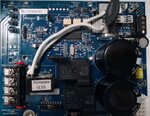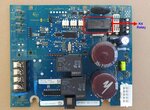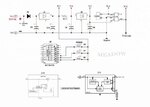Bogey
Newbie level 2

Hi guys - newbie/first post here. I would definitely consider myself an electronic "hobbyist"; maybe level 3 on a scale of 10. Most of my background is wiring car stereos - which translated to stereos built into coolers to take floating on the river. I did successfully build a radio controlled lawn mower with a couple of deep cycle wheel chair batteries and wheel chair motors and a motor controller (probably the most difficult project I've completed). I've also done a couple projects with relays and a raspberry pi. But I say all that to give you my experience level. There's a lot of very smart people on this forum from the stuff I've read, so please - talk as if you would to a young child  .
.
My current project: I have a pool that has a salt water chlorine generator (SWG). It's a Hayward Aquarite model. The PCB model number is GLX-PCB-RITE (Amazon.com PCB). Over the past 6 or 7 years, every time I open the pool for pool season, it seems I have to replace a component on the PCB called the thermistor - inrush current limiter (AS32 2R025) because it constantly burns out. Of course I'm familiar with resistors, capacitors, etc - but I had never heard of this component until this. So I had to do my research and get familiar with them.
The way I understand it, there's two kinds: Negative Temp Coefficient (NTC) and Positive (PTC). The thermistor on my board is NTC.
They are wired in series and have a very high resistance when the current is cold. As the current increases and heats up, resistance value is lowered and allows normal current to flow. PTC just works the opposite - low resistance at cold and higher as temp increases. But like I said, I'm a small level hobbyist, so my terminology or understanding could be wayyyy off.
This is actually a very common issue with this PCB (and other brands as well). So my question is - is there something I can do or replace with to make it more reliable? Or - what I was thinking was to make this part into a quick replacement component on the PCB, somehow....like changing out a blade fuse, instead of constantly disconnecting everything from the PCB, desoldering the old, and soldering the new. Any ideas? I think something like that could work - but I have no clue on the specs, like the gauge the leads would have to be, temp issues, etc.
My current project: I have a pool that has a salt water chlorine generator (SWG). It's a Hayward Aquarite model. The PCB model number is GLX-PCB-RITE (Amazon.com PCB). Over the past 6 or 7 years, every time I open the pool for pool season, it seems I have to replace a component on the PCB called the thermistor - inrush current limiter (AS32 2R025) because it constantly burns out. Of course I'm familiar with resistors, capacitors, etc - but I had never heard of this component until this. So I had to do my research and get familiar with them.
The way I understand it, there's two kinds: Negative Temp Coefficient (NTC) and Positive (PTC). The thermistor on my board is NTC.
They are wired in series and have a very high resistance when the current is cold. As the current increases and heats up, resistance value is lowered and allows normal current to flow. PTC just works the opposite - low resistance at cold and higher as temp increases. But like I said, I'm a small level hobbyist, so my terminology or understanding could be wayyyy off.
This is actually a very common issue with this PCB (and other brands as well). So my question is - is there something I can do or replace with to make it more reliable? Or - what I was thinking was to make this part into a quick replacement component on the PCB, somehow....like changing out a blade fuse, instead of constantly disconnecting everything from the PCB, desoldering the old, and soldering the new. Any ideas? I think something like that could work - but I have no clue on the specs, like the gauge the leads would have to be, temp issues, etc.






